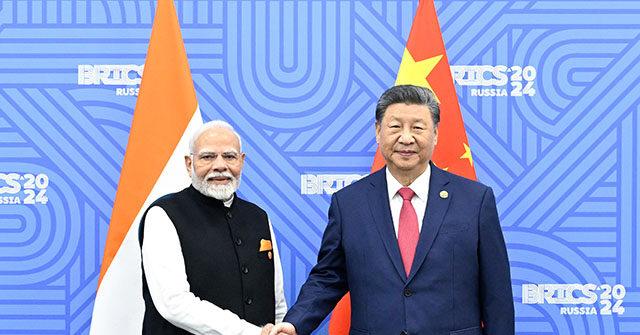Indian Prime Minister Narendra Modi urged his citizens to buy local products and scheduled a rare diplomatic visit to regional adversary China, as trade negotiations with the United States came to an impasse this week.
Sources in the Modi administration said on Wednesday the prime minister will visit China for a summit meeting of the Shanghai Cooperation Organization (SCO), the regional security bloc India and its arch-rival Pakistan joined in 2017.
Modi led India’s delegation to the SCO summit in 2018 and has not been back since. The bloc is increasingly dominated by China, which hosts its meetings, and relations between New Delhi and Beijing have been strained over territorial and economic disputes over the past seven years.
China has also nudged the SCO into becoming a “counter” to the Group of Seven nations and it has taken some positions that are highly antagonistic toward the G7 consensus, such as declaring support for the brutal Taliban regime in Afghanistan. India, meanwhile, sought to align itself more strongly with the U.S. and G7, while simultaneously striving to maintain close bilateral relations with fellow SCO member Russia.
Perhaps the biggest hurdle to India exercising its SCO membership privileges in recent years has been the presence of Pakistan. When the SCO defense ministers held a meeting in China in June, Indian Defense Minister Rajnath Singh refused to sign the summit’s joint statement on the terrorist attack in Kashmir that nearly started a war between India and Pakistan. India felt the joint statement let Pakistan off the hook for coddling, or even colluding with, the Islamist fanatics who perpetrated the Kashmir massacre.
India’s frosty relations with China began to thaw after Modi met with Chinese dictator Xi Jinping at the October 2024 summit in Kazan, Russia for BRICS, another China-dominated bloc that counts India as a member.
Russian strongman Vladimir Putin counted the summit as a major diplomatic victory for Russia because it gave him photo ops with Modi and Xi, while Russia’s two biggest oil customers began mending fences. The meeting sent a strong signal that the Biden administration’s efforts to isolate and impoverish Putin after he invaded Ukraine were not working.
The Trump administration has become very determined to break India’s addiction to discounted Russian oil. India has publicly refused to abandon its business with Russia, while quietly seeming to meet President Donald Trump roughly halfway by finding new sources for some of its energy imports. Indian officials said their reduced Russian oil purchases were motivated by shrinking discounts, not political considerations or guilt for funding the Russian war machine.
Half-measures on Russian oil were evidently not good enough because on Wednesday President Trump issued an executive order imposing an additional 25 percent tariff on Indian imports, expressly intended to penalize India for jeopardizing U.S. national security by financially supporting Russia’s war in Ukraine.
Trump’s order threatened similar tariffs against any other country found to be “directly or indirectly importing Russian oil.”
Trump previewed his action in a Tuesday interview on CNBC, in which he repeated his judgment that India “has not been a good trading partner, because they do a lot of business with us, but we don’t do business with them.”
“So we settled on 25% (India’s basic tariff rate), but I think I’m going to raise that very substantially over the next 24 hours, because they’re buying Russian oil, they’re fueling the war machine. And if they’re going to do that, then I’m not going to be happy,” Trump said.
Indian National Security Adviser Ajit Doval is currently in Moscow on a mission to “clarify” India’s oil strategy, which apparently means demanding deeper discounts from Russia to offset tariff penalties from the United States. Having demonstrated that it can make do without Russian oil, India seems intent on making Russia sweeten its deals on both energy products and military hardware.
In addition to making overtures to China, Modi has been battening down the hatches for a tariff storm by telling Indian citizens to buy and sell locally at every opportunity.
“The world economy is going through many apprehensions, there is an atmosphere of instability. Now, whatever we buy, there should be only one scale: we will buy those things which have been made by the sweat of an Indian,” Modi said at a political rally on Saturday.
Modi hinted at the same rally that he would never budge on protectionist tariffs and regulations to shield Indian agriculture from foreign competition – the other major sticking point in trade negotiations with the United States, besides Russian oil.
“The interests of our farmers, our small industries and the employment of our youth are of paramount importance,” he declared.
A third issue of great importance to the Trump White House has been thwarting efforts by China and its BRICS partners to weaken the importance of the U.S. dollar to global trade. Trump has threatened to slap additional ten percent punitive tariffs on “any country aligning themselves with the anti-American policies of BRICS,” without exceptions. India is probably the only founding BRICS member that might have expected such an exception, the others being Brazil, Russia, China, and South Africa.
With the punitive oil tariff Trump announced on Wednesday in place, India will be paying far higher tariffs that most of its Southeast Asian competitors, which might push India further into the Russia-China-BRICS orbit, or give Modi second thoughts about sacrificing India’s access to the titanic American market.
The outlines of a deal that would satisfy Trump are visible and his executive order on Wednesday said his punitive tariffs could be lifted as quickly as they were imposed. The ball is in Modi’s court now, and the time for playing the West and Russia against each other to see who offers a better bargain is almost over.
Read the full article here


